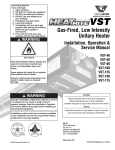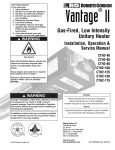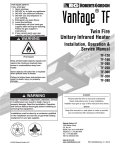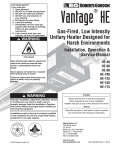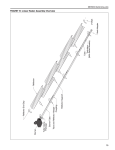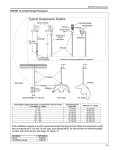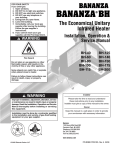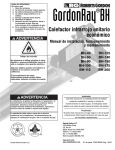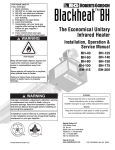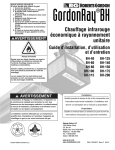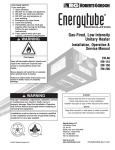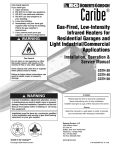Download Roberts Gorden CTH2 Series Service manual
Transcript
SECTION 7: OPTIONAL HEATER ACCESSORIES Step 7.2.4 Reflector Joint Installation Cut away contour with tin snips. Punch/drill six 3/32" (2 mm) holes. Step 7.2.5 Reflector Joint Detail Install reflector end cap. Attach reflector joint with six #8 sheet metal screws. FIGURE 19: Reflector Joint Detail Reflector Reflector Joint 25 CTH2-SERIES INSTALLATION, OPERATION AND SERVICE MANUAL 7.3 Reflector Side Extension Step 7.3.1 Bracket Installation Tube Reflector Tube and Reflector Hanger Reflector Support Reflector Side Extension Bracket (2 per reflector) Use additional supports in high air movement applications. Description Reflector Side Extension Package Reflector Side Extension Retainer Clips Sheet Metal Screws Order Separately Reflector Side Extension Part Number 02712700 01368000 02751200 94118106 01329910 Step 7.3.2 Side Reflector Installation #8 x 3/8" Sheet Metal Screw Cut relief notches for supports and hangers. Retainer Clip (2 per side) Reflector Side Extension 26 SECTION 7: OPTIONAL HEATER ACCESSORIES 7.4 Lower Clearance Shield Installation Step 7.4.1 Shield Support Strap Assembly Reflector 17.1" (434 mm) 12" (300 mm) Align Pilot Holes Lower Clearance Shield Locknuts Washers Screws Description Lower Clearance Shield Package Shield Support Strap Lower Clearance Shield 8' Locknut #8 Flat Washer #8 Screw #8 x 3/8" Part Number 01397501 01397500 02793000 92311400 95310800 93511406 7.5 Two-Foot Decorative Grille Installation Step 7.5.1 Grille Installation Tube and Reflector Hanger Reflector Tube 2' x 4' (61 x 122 cm) Aluminum Grille Suspended Ceiling Frame Description Aluminum Grille 2’ x 4’ Part Number 91407000 27 CTH2-SERIES INSTALLATION, OPERATION AND SERVICE MANUAL Step 7.5.2 Frame Shield Installation Shield Description Deco Grille Shield Part Number 01365900 Step 7.5.3 Reflector Side Extension Installation for Decorative Grilles NOTE: If the Decorative Grille system is to be installed in an area with considerable air movement, it is recommended that one #8 x 3/8 (3.9 x 9.5 mm) sheet metal screw be installed per reflector extension to prevent it from blowing over. Cut Relief Notches for Tube and Reflector Hangers Insert Screw here A Reflector Side Extension Distance "A" Minimum Maximum 2" (4 cm) 6" (15 cm) 6" (15 cm) 10" (26 cm) 10" (26 cm) 14" (37 cm) 28 Extension Part No. Width 01370408 8" (20 cm) 01370412 12" (30 cm) 01370416 16" (40 cm) Description Reflector Side Extension Part Number 01370412 SECTION 7: OPTIONAL HEATER ACCESSORIES 7.6 One-Foot Decorative Grille Installation Step 7.6.1 One-Foot Decorative Grille Bracket #8 Sheet Metal Screws Decorative Grille Bracket Description Bracket Part Number 01363003 In order to maintain reflector shape, do not fasten brackets together. Do not fasten bracket to adjoining reflectors. Maintain same slipjoint position as reflectors. Cut relief notches for supports and hangers. 2" (51 mm) Minimum Bracket Overlap Step 7.6.2 Decorative Grille Spread apart brackets and install Decorative Grille. Description Decorative Grille 8’ x 1’ Part Number 91406700 Step 7.6.3 Joint Piece and Reinforcement Joint Piece Slip joint piece into support bracket and fasten to bracket on one side of the joint only. Description Joint Piece Reinforcement Part Number 01365903 01365902 Reinforcement #8 Sheet Metal Screws Joint Piece 29 CTH2-SERIES INSTALLATION, OPERATION AND SERVICE MANUAL Step 7.6.4 End Piece and Reflector End Cap Reflector End Cap End Piece Insert end piece between grille and brackets. Fasten end piece to brackets using two #8 sheet metal screws and replace reflector end cap. Description End Piece Part Number 01365901 Step 7.6.5 90° Elbow Inside Corner Grille Brackets Joint Piece Insert End Piece between grille and brackets. Decorative Grille Brackets 30 Cut grille bracket at reflector joint piece. Joint Piece SECTION 7: OPTIONAL HEATER ACCESSORIES 7.7 Protective Grille Installation Step 7.7.1 Silicone Cap Installation Silicone Cap Description Grille Section Grille End Cap Silicone Cap Grille Finger Part Number 08050001 08050002 91915951-6P Step 7.7.2 Grille End Cap Installation B A Grille Grille End Cap C D Bend up 90° Pull outward Step 7.7.3 Grille Installation Reflector 40" (101 cm) Grille Final Grille Section Grille End Cap 31 CTH2-SERIES INSTALLATION, OPERATION AND SERVICE MANUAL SECTION 8: VENTING WARNING Carbon Monoxide Hazard Heaters installed unvented must be interlocked with sufficient building exhaust. Secure all joints with #8 x 3/8 sheet metal screws. Seal all joints with high temperature silicone sealant. Heaters must be installed according to the installation manual. 8.1.1 United States Requirements Vent must terminate at least 3' (.9 m) above any forced air inlet located within 10' (3.1 m). Failure to follow these instructions can result in death or injury. 8.1 Venting This heater must be vented in accordance with the rules contained in this manual and with the following national codes and any state, provincial or local codes which may apply: United States: Refer to ANSI Z223.1 (NFPA 54) - latest revision; Canada: Refer to CAN/CGA-B149.1 and B149.2 - latest revision. Exhaust end of heater will accept a 4” (10 cm) vent pipe using the vent adapter (P/N 90502700). To prevent leakage of condensation, install the vent adapter with the seam on top and seal the joint using a high temperature silicone sealant. Any portion of vent pipe passing through a combustible wall must have an approved thimble (P/N 90505600) to conform with the above listed codes. Vent pipe must be sloped downward away from the burner 1/2” (1 cm) for every 20' (6 m). The heater may be individually vented or common vented. When venting horizontally, a maximum of two heaters can be commonly vented. See Page 34, Section 8.9. When venting vertically, a maximum of four heaters can be commonly vented. See Page 35, Section 8.10. The heater may also be installed unvented in certain circumstances according to building ventilation codes. Refer to the above codes and Page 32, Section 8.2 for further information. Unvented operation also requires compliance with the clearances to combustibles given on Page 6, Figure 10. The bottom of the vent or air intake terminal shall not be located less than 1' (.3 m) above grade level. The vent shall not terminate less than 7' (2.1 m) above grade where located adjacent to public walkways. 32 Vent terminal must be installed at a height sufficient to prevent blockage by snow and building materials protected from degradation by flue gasses. Vent terminal must be beyond any combustible overhang. Vent must terminate at least 4' (1.2 m) below, 4' (1.2 m) horizontally from, or 1' (.3 m) above any door, operable window, or gravity air inlet into any building. 8.1.2 Canadian Requirements The vent shall not terminate within 6' (1.8 m) of a mechanical air supply inlet to any building. The vent shall not terminate within 3' (.9 m) of a window or door that can be opened in any building, any non-mechanical air supply inlet to any building, or of the combustion air inlet of any other appliance. 8.2 Unvented Operation Sufficient ventilation must be provided in the amount of 4 cfm per 1000 Btu/h firing rate (United States); 3 cfm per 1000 Btu/h firing rate (Canada). Use of optional outside combustion air is not recommended with unvented heaters. If exhaust fans are used to supply ventilation air, an interlock switch must be used to prevent the heater from coming on when the fans are off. This may be done using a pressure switch. 8.3 Horizontal Venting In noncombustible walls only, vent terminal (P/N 02537801-1P) may be used. For 4” (10 cm) vents in either combustible or noncombustible walls, use P/N 90502100 (Tjernlund VH1-4) or equivalent insulated vent terminal. Follow the manufacturer's instructions for proper installation. For 6” (15 cm) common vents in either combustible or noncombustible walls, use P/N 90502101 (Tjernlund VH1-6) or equivalent insulated vent terminal. Follow the manufacturer's instructions for proper installation. 8.4 Vertical Venting For 4” (10 cm), an approved vent cap (P/N 90502300) must be used. For 6” (15 cm) common vent, an approved vent cap (P/N 90502302) must be used. For common vertical venting of more than two heaters, See Page 35, Section 8.10. A vent shall not extend less than 2' (.6m) above the highest point where it passes through a flat roof of a building. SECTION 8: VENTING 8.6 Length Requirements The maximum vent length allowed is 45' (13.7 m). The maximum outside air supply duct length allowed is 45' (13.7 m). The total vent length, plus outside air duct length, plus any extensions to minimum heat exchanger lengths, cannot exceed 65' (19.8 m). 8.5 Unvented Operation Tube Termination Turndown type vent terminal with a screen must be installed at the exhaust end of the tube. Vent terminal design shall not incorporate backdraft flap. FIGURE 20: Tube Termination Vent length should be limited to less than 20' (6 m). If using vent lengths greater than 20' (6 m), condensation will form in the vent pipe. Insulation and additional sealing measures (high temperature silicone at all seams) are required. Optional heat exchanger beyond minimum lengths is considered as vent length for length determination. Subtract 15' (4.6 m) of maximum allowed vent or duct length per vent elbow if more than two are used. 8.7 Horizontal Ventilation 4" (10 cm) Pipe SIDE VIEW Combustible or Non-Combustible Wall Non-Combustible Wall Only Vent Adapter Vent Adapter 18" Min. 4" Single Wall Pipe Vent Terminal 4" Single Wall Pipe Vent Terminal Description Part Number Vent Terminal (Comb. Wall) 90502100 Vent Terminal 02537801-XX Wall Thimble 90505600 8.8 Vertical Ventilation 4" (10 cm) Pipe 4" (10 cm) Type "B" vent cap SIDE VIEW 4" (10 cm) Type "B" vent pipe 18" (46 cm) Min. Roof Flashing Roof Approved Thimble Vent Adapter (If Applicable) 4" (10 cm) Single Wall Pipe Description Vent Cap 4" (10 cm) The last section of vent pipe passing through the roof or wall may be Type "B" vent pipe. All other vent materials in the building must be single wall vent pipe. Part Number 90502300 33 CTH2-SERIES INSTALLATION, OPERATION AND SERVICE MANUAL 8.9 Common Sidewall Venting TOP VIEW Vent Terminal Tjernlund VH1-6 or Equivalent Outside Wall Vent Adapter 6" Single Wall Pipe Sweeping 'T' Connection Vent Adapter 4" Single Wall Pipe Vent Terminal Tjernlund VH1-6 or Equivalent Outside Wall 6" Single Wall Pipe Vent Adapter Sweeping 'Y' Connection 4" Single Wall Pipe 4" Single Wall Pipe Description Vent Terminal 6" (15 cm) Part Number 90502101 Vent Adapter Requirements: • Maximum of 2 heaters can be commonly vented through a side wall. • Heaters must be of the same BTU output. • Heaters must be controlled by a common thermostat. 34 SECTION 8: VENTING 8.10 Common Vertical Venting Type "B" vent cap (7" or 8") may be used. (These are not available from Roberts-Gordon.) Type "B" Vent Pipe SIDE VIEW Roof Flashing 18" (46 cm) Min. Roof Vent Adapter The last section of vent pipe passing through the roof or wall may be Type "B" vent pipe. All other vent materials in the building must be single wall vent pipe. 4" (10 cm) Single Wall Pipe Approved Thimble (If Applicable) Single Wall Pipe D D Area must equal sum of open area of individual vents. Vent Adapter 4" (10 cm) Single Wall Pipe TOP VIEW Requirements: • Heaters must be controlled by a common thermostat. • Connections to a common stack must be positioned to avoid direct opposition between streams of combustion gases. 35 CTH2-SERIES INSTALLATION, OPERATION AND SERVICE MANUAL 8.11 Outside Combustion Air Supply IMPORTANT: If the building has a slight negative pressure or corrosive contaminants, such as halogenated hydrocarbons, are present in the air, an outside combustion air supply to the heater is required. Seal all combustion air pipe joints. The air supply duct may have to be insulated to prevent condensation on the outer surface. The outside air terminal must not be more than 1' (31 cm) above the vent terminal. 8.11.1 Length Requirements Follow the constraints listed on Page 33, Section 8.6. 8.11.2 Vertical Outside Air Supply for Single Heater Installation Vent Cap 18" (46 cm) Min. Roof Flex Hose (Recommended) 4" (10 cm) Single Wall Pipe Burner Band Clamp (Recommended) Description Vent Cap 4" (10 cm) Part Number 90502300 Vent Cap Wall 8.11.3 Horizontal Outside Air Supply for Single Heater Installation 4" (10 cm) Single Wall Pipe Flex Hose (Recommended) Burner Band Clamp (Recommended) Description Vent Cap 4" (10 cm) 36 Part Number 90502300 SECTION 8: VENTING 8.11.4 Vertical Outside Air Supply for Double Heater Installation Vent Cap Roof 6" (15 cm) Single Wall Pipe Flex Hose (Recommended) Burner Band Clamp (Recommended) Description Vent Cap 6" (15 cm) Sweeping 'T' Connection Burner Flex Hose (Recommended) 4" (10 cm) Single Wall Pipe Part Number 90502302 Requirements: • Heaters must be controlled by a common thermostat. 8.11.5 Horizontal Outside Air Supply for Double Heater Installation Vent Cap Outside Wall 6" (15 cm) Single Wall Pipe Flex Hose (Recommended) Burner Sweeping 'Y' Connection 4" (10 cm) Single Wall Pipe (Seal All Joints) Burner Description Vent Cap 6" (15 cm) Part Number 90502302 Band Clamp (Recommended) Requirements: • Heaters must be controlled by a common thermostat. 37 CTH2-SERIES INSTALLATION, OPERATION AND SERVICE MANUAL the gas piping has been completed. SECTION 9: GAS PIPING WARNING There is an expansion of the tube with each firing cycle. This will cause the burner to move with respect to the gas line. This can cause a gas leak resulting in an unsafe condition if the gas connection is not made in strict accordance with Figure 21. Fire Hazard Tighten gas hose fittings to connect gas supply according to Figure 20. Gas hose can crack when twisted. Gas hose moves during normal operation. Failure to follow these instructions can result in death, injury or property damage. Meter and service must be large enough to handle all the burners being installed plus any other connected load. The gas line which feeds the system must be large enough to supply the required gas with a maximum pressure drop of 1/2" w.c. When gas piping is not included in the layout drawing, the local gas supplier will usually help in planning the gas piping. Install the gas hose as shown in Figure 21. The gas hose accommodates expansion of the heating system and allows for easy installation and service of the burner. Before connecting the burners to the supply system, verify that all high pressure testing of • Do not high pressure test the gas piping with the burner connected. Failure to follow these instructions can result in property damage. • Check the pipe and tubing ends for leaks before placing heating equipment into service. When checking for gas leaks, use a soap and water solution; never use an open flame. FIGURE 21: Gas Connection with Flexible Gas Hose Hold gas nipple securely with pipe wrench when attaching the gas hose. Failure to follow these instructions can result in product damage. Shut-Off Valve must be parallel to burner gas inlet. The 2" (5 cm) displacement shown is for the cold condition. This displacement may reduce when the system is fired. Shut-Off Valve (Included With Gas Hose) 2" (5 cm) 12" (30 cm) 45° Side View Horizontal Flexible Gas Hose Description 1/2" Flexible Stainless Steel Gas Hose (US Models) 3/4" Flexible Stainless Steel Gas Hose (US Models) 1/2" Rubber Type 1 Gas Hose (Canadian Models) 3/4" Rubber Type 1 Gas Hose (Canadian Models) 38 Rear View Part Number 91412200 91412203 91412206 91412207 SECTION 10: WIRING SECTION 10: WIRING WARNING Electrical Shock Hazard Disconnect electrical power and gas supply before servicing. This appliance must be connected to a properly grounded electrical source. Failure to follow these instructions can result in death or electrical shock. Heaters can be controlled using several methods. Normally thermostats are used to control the heaters but they can also be controlled by an Energy Management System. Section 10.1 below illustrates the connection for heaters controlled by a line voltage thermostat. NOTE: In order to use line voltage thermostats, the low voltage terminal located at the back of each burner must be connected as shown in the detail. For a single heater on a low voltage thermostat, See Section 10.2 below. To control multiple heaters on one low voltage thermostat, See Page 40, Section 10.3. NOTE: In order to control multiple heaters on one low voltage thermostat, the low voltage terminals on each heater must be connected as shown in detail. Heaters must be grounded in accordance with applicable codes: United States: refer to National Electrical Code® ANSI/NFPA 70 - latest revision; Canada: refer to Canadian Electrical Code CSA C22.1 Part I - latest revision. If any of the original internal wiring must be replaced, it must be replaced with wiring materials having a temperature rating of at least 105° C and 600 V. 10.1 Line Voltage Thermostat Wiring Line Voltage Thermostat 120 V-60 Hz Supply Circuit Gnd. T H L1 L2 Gnd. Gnd. N H N Low Voltage Terminal Detail On All Burners 10.2 Low Voltage Thermostat with One Burner 120 V-60 Hz Supply Circuit L1 L2 Gnd. H N T Gnd. Low Voltage Thermostat Low Voltage Terminal Detail 39 CTH2-SERIES INSTALLATION, OPERATION AND SERVICE MANUAL 10.3 Low Voltage Thermostat Wiring with Multiple Burners FRONT VIEW Transformer Relay 1 R 3 2 4 Black BACK VIEW COIL 5 Low Voltage Thermostat (P/N 90425100) C 6 COIL W G Y Purple Black White Burner 1 Red 120V-60Hz supply circuit Burner 2 Gnd. H Gnd. N H N L1 L2 Burner 3 Gnd. When using 1-2 burners, use SPDT Transformer Relay (P/N 90417600). When using 3-4 burners, use DPDT Transformer Relay (P/N 90436300). Burner 4 Gnd. Red/Yellow H Gnd. N H N 10.4 Internal Wiring SMART VALVE 120V-60Hz supply circuit TRANSFORMER L2 L1 WHITE BLACK Gnd. 1 5 3 4 WHITE YELLOW ORANGE BLUE YELLOW COM PURPLE TO THERMOSTAT GREEN PRESSURE SWITCH COM DOOR N.O. SWITCH BLACK BLACK WHITE WHITE BLACK BLACK WHITE TERMINAL GREY BUSHING FLAME SENSOR MOTOR/BLOWER GREEN 40 N.O. IGNITER Low Voltage Terminal Detail on all Burners SECTION 10: WIRING 10.5 Ladder Diagram L2 L1 TRANSFORMER WHITE BLACK ORANGE BLUE VALVE WHITE TO THERMOSTAT PRESSURE SWITCH YELLOW YELLOW PURPLE HOT SURFACE IGNITER WHITE WHITE WHITE BLACK DOOR SWITCH GREY FLAME SENSOR MOTOR WHITE BLACK 10.6 Electrical Connection to the Burner Electrical Cord or Flexible Conduit BX or Romex Connector Burner Connect wires together with suitable approved wire connectors. L1 L2 Ground Green to Ground White to L2 Black to L1 Black White Green Junction Box 41 CTH2-SERIES INSTALLATION, OPERATION AND SERVICE MANUAL SECTION 11: OPERATION AND MAINTENANCE This heater is equipped with a hot-surface ignition system. 11.3 To Start Heater 11.1 Sequence of Operation 1. Turn the thermostat up. When the thermostat calls for heat, the SmartValve® II will energize. After a short period, power is supplied to the blower motor. Turn ON main gas valve. 2. When the motor approaches nominal running RPM, the pressure switch closes and signals the ignition module/SmartValve® II. 3. The ignition module/SmartValve® II then energizes the hot-surface igniter for a timed warm-up period (approximately 45 to 60 seconds). After the warm-up period, the gas valve is energized. 4. If a flame is detected, the gas valve remains open and the igniter is de-energized. When the call for heat is satisfied and the system control mechanism de-energizes the burner line voltage supply, the gas is turned off. 5. If no flame is detected by the flame sensing rod, the igniter is de-energized and the module/ SmartValve® II will close and a purge period begins. After the purge, the module/SmartValve® II acts to power the igniter for a second warm-up period and a second trial for ignition period. If flame is still not established, a third purge, warm-up, and trial cycle begins. After four trials, the module/SmartValve® II will lockout for one hour or until reset. 6. If the flame extinguishes during operation, the igniter module will provide multiple trial sequences described in step 5. If ignition is not re-established, the module/SmartValve® II will lockout for one hour or until reset. 7. After lockout, reset by turning down thermostat for five seconds, and then raising it again to desired temperature, or by disconnecting power and then reconnecting. 11.2 To Shut Off Heater Set thermostat to lowest setting. Turn OFF electric power to heater. Turn OFF manual gas valve in the heater supply line. 42 Turn gas valve and electric power OFF and wait five minutes for unburned gases to vent from heater. Turn ON electric power. Set thermostat to desired temperature. Burner should light automatically. 11.4 Pre-Season Maintenance and Annual Inspection WARNING Turn off gas and electrical supplies before performing service or maintenance. Failure to follow these instructions can result in death, injury or property damage. To ensure your safety and years of trouble-free operation of the heating system, service and annual inspections must be done by a contractor qualified in the installation and service of gas-fired heating equipment. Turn off gas and electric supplies before performing service or maintenance. Allow heater to cool before servicing. Before every heating season, a contractor qualified in the installation and service of gas-fired heating equipment must perform a thorough safety inspection of the heater. For best performance, the gas, electrical, thermostat connections, tubing, venting, suspensions and overall heater condition should be thoroughly inspected. NOTE: Gas flow and burner ignition are among the first things that should be inspected. Please see Page 43, Section 11.5 for suggested items to inspect. SECTION 11: OPERATION AND MAINTENANCE 11.5 Maintenance Checklist WARNING Turn off gas and electrical supplies before performing service or maintenance. Failure to follow these instructions can result in death, injury or property damage. The Vicinity of the Heater Installation Code and Annual Inspections: All installations and service of ROBERTS GORDON® products must be performed by a contractor qualified in the installation and service of gas-fired heating equipment and conform to all requirements set forth in the ROBERTS GORDON® manuals and all applicable governmental authorities pertaining to the installation, service and operation of the equipment. To help facilitate optimum performance and safety, Roberts-Gordon recommends that a qualified contractor annually inspect your ROBERTS GORDON® products and perform service where necessary, using only ROBERTS GORDON® replacement parts. Do not store or use flammable objects, liquids or vapors near the heater. Immediately remove these items if they are present. See Page 3, Section 3. Vehicles and Other Objects Maintain the clearances to combustibles. Do not hang anything from, or place anything on, the heater. Make sure nothing is lodged underneath the reflector, in between the tubes or in the decorative or protective grilles (included with select models). Immediately remove objects in violation of the clearances to combustibles. See Page 3, Section 3. Reflector Make sure there is no dirt, sagging, cracking or distortion. Do not operate if there is sagging, cracking or distortion. Make sure reflectors are correctly overlapped. See Page 19, Section 6.5.1. Clean outside surface with a damp cloth. Vent Pipe Venting must be intact. Using a flashlight, look for obstructions, cracks on the pipe, gaps in the sealed areas or corrosion. The area must be free of dirt and dust. Remove any carbon deposits or scale using a wire brush. See Page 32, Section 8. Outside Air Inlet Inlet must be intact. Look for obstructions, cracks on the pipe, gaps in the sealed areas or corrosion. The area must be free of dirt and dust. Clean and reinstall as required. 43 CTH2-SERIES INSTALLATION, OPERATION AND SERVICE MANUAL Tubes Make sure there are no cracks. Make sure tubes are connected and suspended securely. See Page 11, Section 6. Make sure there is no sagging, bending or distortion. Clean or replace as required. Gas Line Check for gas leaks. See Page 38, Section 9. Burner Observation Window Make sure it is clean and free of cracks or holes. Blower Scroll, Wheel and Motor Compressed air or a vacuum cleaner may be used to clean dust and dirt. Burner Cup and Orifice Clear of obstructions (even spider webs will cause problems). Clean and replace as required. Carefully remove any dust and debris from the burner. Hot-Surface Igniter Replace if cracked or broken. Thermostat There should be no exposed wire or damage to the thermostat. See Page 39, Section 10. Suspension Points Make sure the heater is hanging securely. Look for signs of wear on the chain or ceiling. See Page 11, Figure 12. Decorative and Protective The grille must be securely attached. Grille (optional) Check that the side reflector extensions are installed correctly and secured in place if necessary. (Decorative grille only.) See Page 27, Section 7.5 and Page 31, Section 7.7. Make sure shield is installed correctly and secured in place if necessary. (Decorative grille only.) See Page 28, Section 7.5.2. Lower Clearance Shield (optional) The lower shield must be securely attached. Inspect shield support straps and lower clearance shield anchor points. See Page 27, Section 7.4. Make sure shield is installed correctly and secured in place if necessary. See Page 27, Section 7.4. 44 SECTION 12: TROUBLESHOOTING SECTION 12: TROUBLESHOOTING 12.1 Honeywell SmartValve® II Troubleshooting WARNING Turn off gas and electrical supplies before performing service or maintenance. Failure to follow these instructions can result in death, injury or property damage. This heater is supplied with the Honeywell SmartValve® II control system. This system is equipped with a diagnostic function that will assist in performing troubleshooting. The LED (Light Emitting Diode) indicator at the top of the SmartValve® II control will flash in various patterns to indicate status. The LED status indication chart provided below gives a summary of possible faults. LED Status Indicates Off No power to the control. Bright-Dim Normal Operation. This indication shows whenever the system is powered, unless some abnormal event has occurred. 2 Flashes Pressure switch remains closed longer than 30 seconds after a call for heat begins (pressure switch stuck closed). The SmartValve® II checks the status of the pressure switch contacts and must see a change in the contact with every firing cycle. Placing a jumper at the switch out of sequence will result in a fault, with the LED indicator flashing 2 times. 3 Flashes Pressure switch remains open longer than 30 seconds after combustion air blower is energized. Check for correct blower operation, blower intake obstructions, pressure switch tubing and wiring. 4 Flashes Limit string open, 2" white jumper wire on valve is loose. 5 Flashes Flame signal sensed out of proper sequence. 6 Flashes System Lockout. Flame sensing circuit is not functioning properly. Perform the checks following the "Does the burner stay lit?" bubble in the troubleshooting flow chart on Page 46, Section 12.2. WARNING Electrical Shock Hazard Do not disconnect ground leads inside heater. Do not interchange grounded and ungrounded leads on transformer or ignition module. Failure to follow these instructions can result in death or electrical shock. Page 48, Section 12.3 will provide the information needed to test the manifold gas pressure setting. Page 46, Section 12.2 will guide you through several troubleshooting steps to determine possible problems with the systems. 45 46 Does the igniter warm up and glow red? YES Turn on thermostat. Does blower turn on? START NO Check voltage at igniter connection. Is it 120V during the ignition period? Inspect igniter carefully. Hairline cracks may not be apparent. Is the igniter damaged? NO Is the voltage between the black and white transformer leads 120V? NO Is the voltage between the blue and orange transformer leads 24V? Remove obstruction. NO YES YES Check wiring and hose connection to pressure NO switch. Are they OK? Replace door. NO Is blower side door in place? YES NO YES YES Is the inlet or outlet of the unit obstructed? Find the source of the electrical problem. NO Check thermostat and wiring. Is the power supply to unit 120V? Check wiring and connection diagram. NO NO Replace transformer. YES Replace wiring and/or hose connections. YES Replace blower. NO Is the blower obstructed? YES Check voltage to motor. Is it 120V? NO Depress switch. Does blower come on? Check wire connections. YES Is the resistance through the igniter 50-400W? Replace pressure switch. YES NO YES NO YES Within 30 seconds of power up, place jumper between both yellow NO wires at pressure switch. Does the igniter glow red? Check wiring and diagram. NO Remove door. Is voltage at door switch 120V? Replace igniter. YES Replace SmartValve® II Remove obstruction. Replace switch. Check door fit; if damaged, replace door. CTH2-SERIES INSTALLATION, OPERATION AND SERVICE MANUAL 12.2 Troubleshooting Flow Chart Were the gas lines purged of air? NO purge gas line. NO NO YES NO NO Repair/ correct wiring. Repair/ correct wiring. Is the wiring at the YES SmartValve® II OK? Adjust to proper pressure. See Section 12.3. NO YES Replace wires. Repair/ correct wiring. NO Replace flame sensor. NO Is the flame sensor dirty? YES YES Clean flame sensor. Repair/ Replace. Check for proper orifice. Check for proper air plate. NO Is the flame Is the insulation on the flame sensor YES sensor positioned NO properly? lead OK? Check outlet gas pressure during ignition period. Is the natural gas pressure 3.5" W.C.? (LP pressure 10.5" W.C.?) YES Are L1 and L2 reversed? Contact Roberts-Gordon at www.rg-inc.com Check the continuity of the ground wire. Check the thermostat. Repair/ correct wiring. NO Is the continuity of the ground wire OK? TROUBLESHOOT ENDS If the problem persists, contact your OR ROBERTS GORDON® Independent Distributor. YES Does burner run until the call for heat ends? YES Does the burner stay on? YES * Check inlet gas cock * Contact gas company * Adjust the regulator NO SmartValve® II ignition system control switch must be in the on position. Check inlet gas pressure during ignition YES period. Is the natural gas pressure at least 4.6" W.C.? 5.0" W.C. for model CTH2-175 (LP pressure 11" W.C.?) YES Replace SmartValve® II. NO Does the burner light? Are the wires to and from the SmartValve® II OK? YES NO YES After igniter warmup period, does the valve click? YES SECTION 12: TROUBLESHOOTING 47 CTH2-SERIES INSTALLATION, OPERATION AND SERVICE MANUAL 12.3 Manifold Gas Pressure Setting Orifice Top View of Heater Manometer 6 5 4 3 2 1 0 1 2 3 4 5 6 Natural 48 3.5" 6 5 4 3 2 1 0 1 2 3 4 10.5" 5 6 Propane SECTION 13: REPLACEMENT PARTS SECTION 13: REPLACEMENT PARTS Use only genuine ROBERTS GORDON® replacement parts. Use of parts not specified by Roberts-Gordon voids warranty. Failure to follow these instructions can result in property damage. Motor and Blower Assembly Blower Inlet Gasket Door Switch Burner Cup Assembly Mica Window Assembly Orifice Air Adapter Collar Gas Valve Hot Surface Igniter Pressure Switch SmartValve R II Flame Sensor Jumper Wire P/N 03090900 Tube Gasket Thermostat Connection Transformer 49 CTH2-SERIES INSTALLATION, OPERATION AND SERVICE MANUAL Description Gas Valve (Natural) Gas Valve (LP) Tube Gasket Blower Inlet Gasket Motor and Blower Assembly Air Adapter Collar Door Switch Burner Cup Assembly Hot Surface Igniter Mica Window Assembly Flame Sensor Transformer Thermostat Connection Jumper Wire Pressure Switch: (175) (80, 100) (150) (40, 60, 125) 50 Part Number 90068300 90068302 02568200 03050900 90708600 91911700 90436800 03020100 90436603K 02553203 90439300 90436900K 91317900 03090900 90439802K 90439803K 90439804K 90439805K SECTION 14: GENERAL SPECIFICATIONS SECTION 14: GENERAL SPECIFICATIONS 14.1 Material Specification 14.1.1 Reflectors 14.3 Suspension Specifications .024 Aluminum (optional .024 Stainless Steel Type 304) 14.4 Controls Specifications Hang heater with materials with a minimum working load of 75 lbs (33 kg). See Page 11, Figure 12. Time switches, thermostats, etc. can be wired into the electrical supply. External controls supplied as an optional extra. 14.2 Heater Specifications 14.2.1 Ignition Fully automatic hot-surface ignition with safety shut-off. General Specifications for the heaters are as follows: End View Side View Minimum Length "A" Reflector 13.5" (34 cm) 9.5" (24 cm) Burner Tube 17.5" (44 cm) Turbulator (Select Models) Recommended Minimum Mounting Height* Heat Input Rate Length “A” Model (Btu/h) x (1000) Minimum Space Spot CTH2-40 40 10' (3m) 8'-10' (2.4 - 3m) 8' (2.3m) CTH2-60 60 20' (6m) 10'-12' (3 - 3.6m) 9' (2.7m)' CTH2-80 80 20' (6m) 12'-15' (3.6 - 4.5m) 11' (3.3m) CTH2-100 100 30' (9m) 12'-15' (3.6 - 4.5m) 12' (3.7m) CTH2-125 125 40' (12m) 15'-20' (4.5 - 6m) 15' (4.6m) CTH2-150 150 50' (15m) 20'-25' (6 - 7.6m) 20' (6.1m) CTH2-175 175 60' (15m) 25' (7.6m) 23' (7m) *See Page 3, Section 3 for clearances to combustibles. GAS PRESSURE AT MANIFOLD: Natural Gas: 3.5" w.c. LP Gas: 10.5" w.c. PIPE CONNECTION: 1/2" NPT (for 40, 60, 80, 100, 125) 3/4" NPT (for 150 & 175) DIMENSIONS: Vent Connection Size: 4" (10 cm) Outside Air Connection Size: 4" (10 cm) Refer to figure above for dimensional information. GAS INLET PRESSURE: Natural Gas: for 40,60,80,100,125,150 for 175 4.6" w.c.Minimum 5.0" w.c.Minimum 14.0" w.c.Maximum LP Gas: 11.0" w.c.Minimum 14.0" w.c.Maximum ELECTRICAL RATING (ALL MODELS): 120 V - 60 Hz., 1.0 A (run) 5.0 A (Start) 51 CTH2-SERIES INSTALLATION, OPERATION AND SERVICE MANUAL SECTION 15: THE ROBERTS GORDON® VANTAGE® II WARRANTY ROBERTS-GORDON WILL PAY FOR: Within 42 months from date of shipment from RobertsGordon, replacement parts will be provided free of charge for any part of the product which fails due to a manufacturing or material defect. Roberts-Gordon will require the part in question to be returned to the factory. Roberts-Gordon will, at its sole discretion, repair or replace after determining the nature of the defect and disposition of part in question. ROBERTS GORDON® Replacement Parts are warranted for a period of 18 months from date of shipment from Roberts-Gordon or the remaining ROBERTS GORDON® VANTAGE® II warranty. ROBERTS-GORDON WILL NOT PAY FOR: Service trips, service calls and labor charges. Shipment of replacement parts. Claims where the total price of the goods have not been paid. Damage due to: • Improper installation, operation or maintenance. • Misuse, abuse, neglect, or modification of the ROBERTS GORDON® VANTAGE® II in any way. • Use of the ROBERTS GORDON® VANTAGE® II for other than its intended purpose. • Incorrect gas or electrical supply, accident, fire, floods, acts of God, war, terrorism, or other casualty. • Improper service, use of replacement parts or accessories not specified by Roberts-Gordon. • Failure to install or maintain the ROBERTS GORDON® VANTAGE® II as directed in the Installation, Operation and Service manual. • Relocation of the ROBERTS GORDON® VANTAGE® II after initial installation • The use of the ROBERTS GORDON® VANTAGE® II in a corrosive atmosphere containing contaminants. • The use of the ROBERTS GORDON® VANTAGE® II in the vicinity of a combustible or explosive material. • Any defect in the ROBERTS GORDON® VANTAGE® II arising from a drawing, design, or specification supplied by or on behalf of the consumer. • Damage incurred during shipment. Claim must be filed with carrier. WARRANTY IS VOID IF: The ROBERTS GORDON® VANTAGE® II is not installed by an electrician qualified in the installation and service of control systems for heating equipment. You cannot prove original purchase date and required annual maintenance history. The data plate and/or serial number are removed, defaced, modified or altered in any way. The ownership of the ROBERTS GORDON® VANTAGE® II is moved or transferred. This warranty is nontransferable. 52 Roberts-Gordon is not permitted to inspect the damaged controller and/or component parts. READ YOUR INSTALLATION, OPERATION AND SERVICE MANUAL If you have questions about your controller, contact your installing professional. Should you need Replacement Parts or have additional questions, call or write RobertsGordon: U.S.A. 1250 William Street P.O. Box 44 Buffalo, New York 14240-0044 716.852.4400 On the web at: www.rg-inc.com Roberts-Gordon's liability, and your exclusive remedy, under this warranty or any implied warranty (including the implied warranties of merchantability and fitness for a particular purpose) is limited to providing replacement parts during the term of this warranty. Some jurisdictions do not allow limitations on how long an implied warranty lasts, so this limitation may not apply to you. There are no rights, warranties or conditions, expressed or implied, statutory or otherwise, other than those contained in this warranty. Roberts-Gordon shall in no event be responsible for incidental or consequential damages or incur liability for damages in excess of the amount paid by you for the ROBERTS GORDON® VANTAGE® II. Some jurisdictions do not allow the exclusion or limitation of incidental or consequential damages, so this limitation or exclusion may not apply to you. This warranty gives you specific legal rights, and you may also have other rights which vary from jurisdiction to jurisdiction. Roberts-Gordon shall not be responsible for failure to perform under the terms of this warranty if caused by circumstances out of its control, including but not limited to war, fire, flood, strike, government or court orders, acts of God, terrorism, unavailability of supplies, parts or power. No person is authorized to assume for Roberts-Gordon any other warranty, obligation or liability. LIMITATIONS ON AUTHORITY OF REPRESENTATIVES: No representative of Roberts-Gordon, other than an Executive Officer, has authority to change or extend these provisions. Changes or extensions shall be binding only if confirmed in writing by Roberts-Gordon's duly authorized Executive Officer. ® OWNER WARRANTY REGISTRATION CARD Mail or Fax to: Roberts Gordon 1250 William Street, P.O. Box 44 Buffalo, NY 14240-0044 Phone: 716-852-4400 Fax: 716-852-0854 Toll Free: 800-828-7450 www.rg-inc.com About the Owner: Name: Address: City: State: Zip Code: Phone: Fax: E-mail: About the Installer: Name: Address: Phone: City: Fax: Purchased From (if different than installer): Name: Address: Phone: Fax: About your Heater: Model#: City: Zip Code: State: Zip Code: E-mail: Serial #: Type of Installation (check one): o Automotive o Manufacturing o Public Building o Office State: E-mail: o Warehouse o Retail Fuel: Installation Date: o Recreational o Agricultural o Aircraft o Other Installation Code and Annual Inspections: All installations and service of ROBERTS GORDON® products must be performed by a contractor qualified in the installation and service of gas-fired heating equipment and conform to all requirements set forth in the ROBERTS GORDON® manuals and all applicable governmental authorities pertaining to the installation, service and operation of the equipment. To help facilitate optimum performance and safety, Roberts-Gordon recommends that a qualified contractor annually inspect your ROBERTS GORDON® products and perform service where necessary, using only ROBERTS GORDON® replacement parts. © 2005 Roberts-Gordon All rights reserved. No part of this work covered by the copyrights herein my be reproduced or copied in any form or by any means graphic, electronic, or mechanical, including photcopying, recording, taping, or information storage and retrieval systems without written permission of Roberts Gordon. Printed in the U.S.A. Attach this information to a wall near the ROBERTS GORDON® heater. ® I n f r a r e d H e a t i n g Read the Installation, Operation, and Service Manual thoroughly before installation, operation, or service. Know your model number and installed configuration. Model number and installed configuration are found on the burner and in the Installation, Operation and Service Manual. Write the largest clearance dimensions with permanent ink according to your model number and configuration in the open spaces below. WARNING OPERATING INSTRUCTIONS 1. STOP! Read all safety instructions on this information sheet. 2. Open the manual gas valve in the heater supply line. 3. Turn on electric power to the heater. 4. Set the thermostat to desired setting. TO TURN OFF THE HEATER 1. Set the thermostat to off or the lowest setting. IF THE HEATER WILL NOT OPERATE, TO ENSURE YOUR SAFETY, FOLLOW THESE INSTRUCTIONS TO SHUT DOWN YOUR HEATER 1. 2. 3. 4. Set the thermostat to off or the lowest setting. Turn off electric power to the heater. Turn off the manual gas valve in the heater supply line. Call your registered installer/contractor qualified in the installation and service of gas-fired heating equipment. Fire Hazard Some objects can catch fire or explode when placed close to heater. Keep all flammable objects, liquids and vapors the required clearances to combustibles away from heater. Failure to follow these instructions can result in death, injury or property damage. Maintain ???? cm clearance to the side and ???? cm clearance below the heater from vehicles and combustible materials. Roberts-Gordon, LLC 1250 William Street P.O. Box 44 Buffalo, NY 14240-0044 USA Telephone: 716.852.4400 Fax: 716.852.0854 Toll Free: 800.828.7450 Roberts-Gordon Europe Limited Oxford Street Bilston, West Midlands WV14 7EG UK Telephone: +44(0) 1902 494425 Fax: +44(0) 1902 403200 Service Telephone: +44(0) 1902 498733 Service Fax: +44(0) 1902 401464 E-mail: [email protected] E-mail: [email protected] Installation Code and Annual Inspections: All installations and service of ROBERTS GORDON® products must be performed by a contractor qualified in the installation and service of gas-fired heating equipment and conform to all requirements set forth in the ROBERTS GORDON® manuals and all applicable governmental authorities pertaining to the installation, service and operation of the equipment. To help facilitate optimum performance and safety, Roberts-Gordon recommends that a qualified contractor annually inspect your ROBERTS GORDON® products and perform service where necessary, using only ROBERTS GORDON® replacement parts. © 2005 ROBERTS GORDON® All rights reserved. No part of this work covered by the copyrights herein may be reproduced or copied in any form or by any means - graphic, electronic, or mechanical, including photocopying, recording, taping or information storage and retrieval systems - without the written permission of Roberts-Gordon. www.rg-inc.com Printed in U.S.A. P/N 91037912 Rev B
































